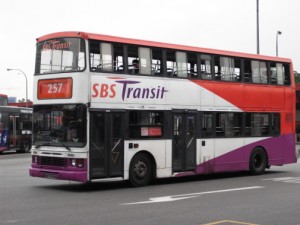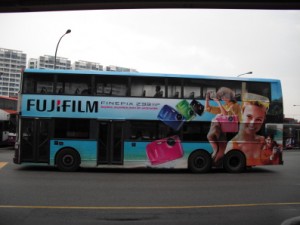Singapore Transit: an introduction
Some pictures are embedded in the post below.
One thing you may have noticed about these postings is that I get a lot of my information about Singapore from cab drivers. No, I am not made of money, that I take cabs around all the time. We live in the far west of the island and don’t have a car, but it doesn’t follow that I need cabs all the time. I hop onto the bus, and then onto the MRT, and am whisked magically almost anywhere. If I am loaded down with groceries or am in a remote spot far from bus stops and train stations, then I call a cab. Cabs are pretty cheap; you can get all the way to the airport for about $30.
To catch a bus or train it’s easiest if you have an EZLink card. These are pre-loaded with money through special machines in the MRT stations; you use your ATM card, tell the machine how much value you want transferred onto your EZLink card, and put in your PIN. You should have a minimum of $3.00 on the card to ride. This ensures that you can go from the far west all the way to the airport by MRT without depleting your card. (Yes, it’s about 10% of the cost of a cab to do that, but it’s also an hour slower.) The EZLink card works on buses and trains and is read by radio-frequency readers when you board and when you disembark the buses, or when you enter and exit the train stations. No messing about with exact change or subway tokens – it’s quick and easy.
The buses are air conditioned and often equipped with TVs that broadcast shows about food and education – sometimes public service announcements and whatever the cause of the week may be: avoiding gambling, second chances for convicts who’ve served their sentences, recycling, preventing the breeding of mosquitoes. And funny home videos. Many buses are double deckers, and it’s really fun to ride on the top through the university campus, because there are so many tall old trees with epiphytic growths clogging their branches, hanging over the road. It’s like jungle trekking 15 feet above the ground, in air conditioned comfort with no mosquitoes.
The only thing that can impede your view up there is the advertising meshes that many buses sport. Singapore’s buses are mainly a purple and orange combination of colors, except for the SMRT lines that are red and white; but all of them can wear plastic mesh skins that cover the windows and tell people to buy beer (Tiger), cameras, soap, or to go to new interesting places – the Bird Park or a new mall. There are two buses I’ve seen around I think of as the Dengue Buses. They sport black meshes with giant photos of mosquitoes, syringes, suffering children or grandparents surrounded by exhausted families, and medical bills. Public service announcements on wheels.
Your EZLink card doesn’t work on cabs, although most of them take credit cards or ATM cards. There’s a central number to call to get a cab; the computer at the far end tracks your phone number and the two most recent spots you called from for a pickup. If you are at one of those spots, you press a button, and if not you speak to an operator. Then the computer searches for a free cab in your area and you hear a message telling you the license number of your cab and how long it will take to get to you. Try not to take someone else’s cab, or a free cab you just happen to see while waiting for your assigned one. If you do, you mess up the queue, although you can easily call the cab phone number and cancel your request or tell the operator you took someone else’s.
Cabs and private cars pay to enter the central business district. During peak hours this is $8.00, and the cost is passed on to the passenger. There are various extra fees built into each cab meter, for pickups, for rides during rush hour, petrol charges for long hauls, waiting fees if you’re stuck in traffic or ask the cab to idle while you do an errand. The meter adds these to the amount due. There are no unmetered cabs, unless you need a maxicab to hold your luggage on your way to or from the airport, and maxicabs always charge a fixed rate.
Sunday mornings are the cheapest time to travel. There’s no rush hour fee, and there’s no downtown entrance charge either!
Pretty easy, right? And I think I mentioned that it’s cheap. Way cheaper than the cost of buying and maintaining a car, which start at $75,000 and have an annual registration cost of $1200. Not to mention the downtown entry fee and parking charges, and the fact that cars over ten years old must be gotten rid of!

